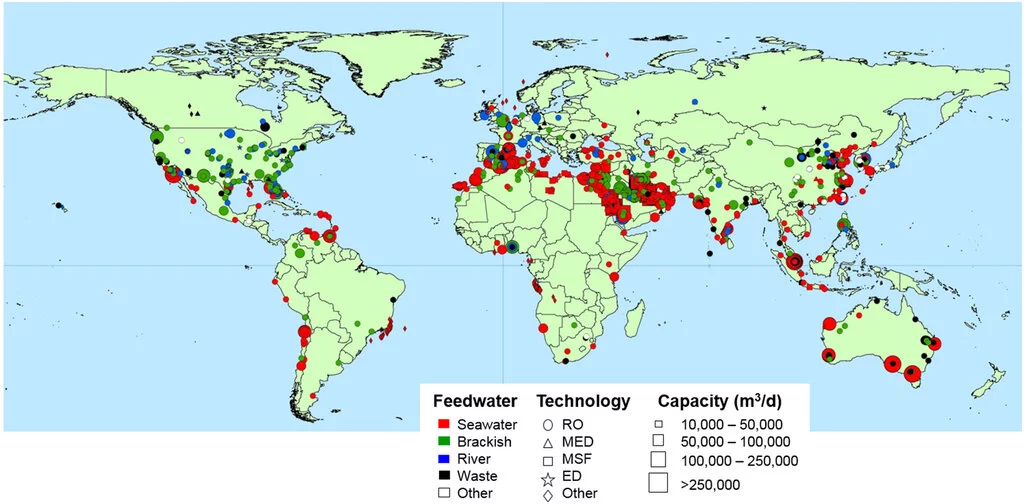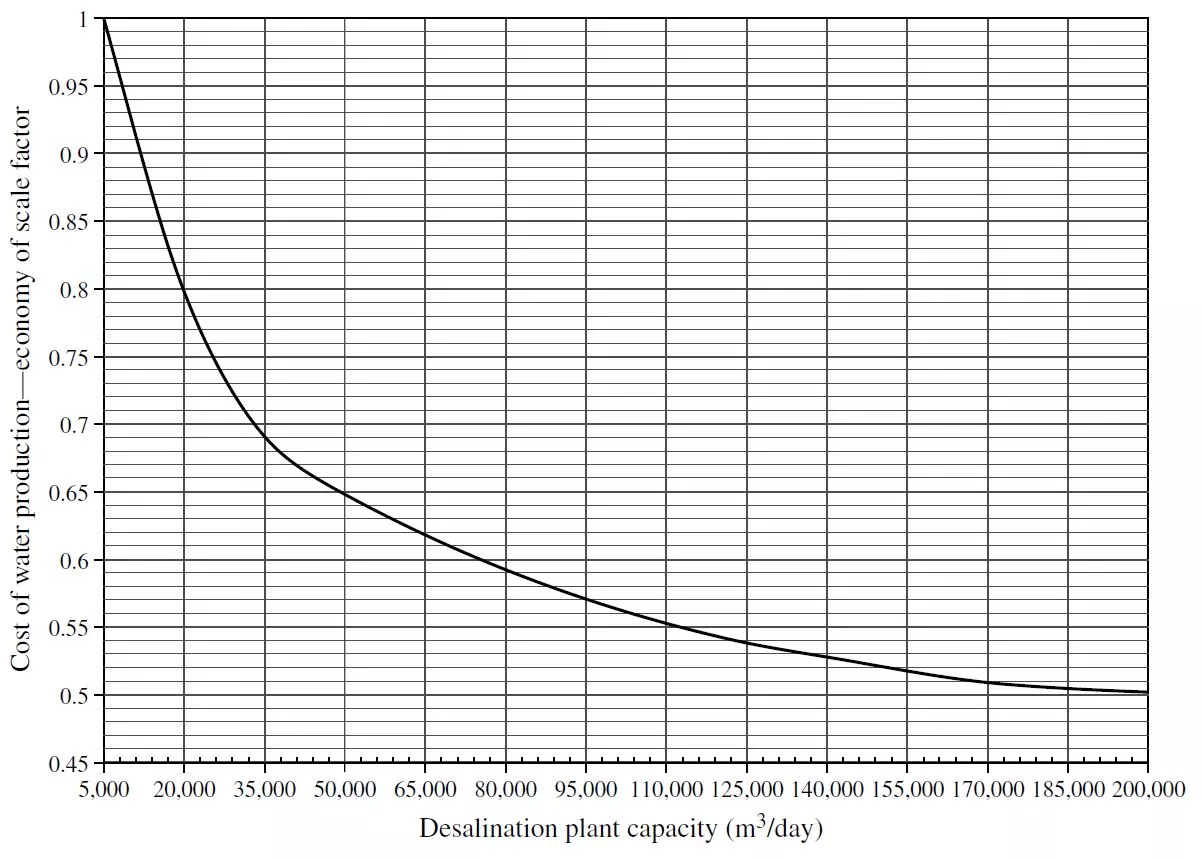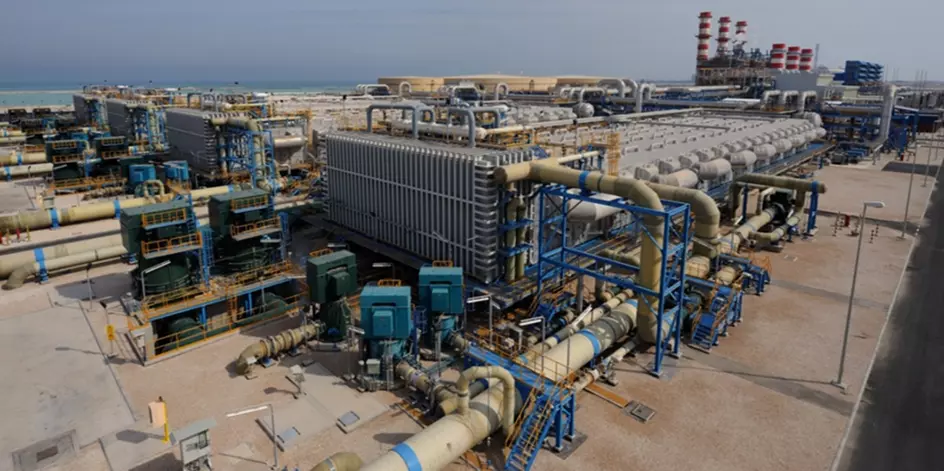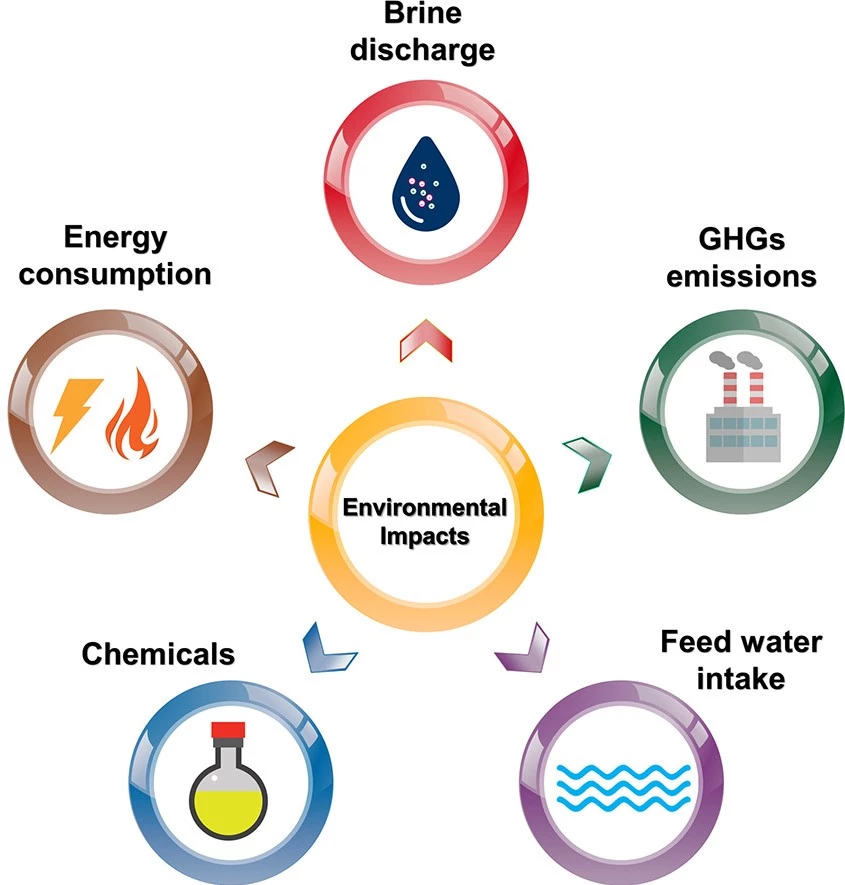Desalination is not generally considered a sustainable method of freshwater production because it consumes a lot of energy and releases brine that pollutes nearby bodies of water. Desalination is only sustainable if we take measures to reduce its environmental effects. These measures include using renewable energy such as solar or wind to power the plant and properly handling discharge water and solid waste.
What is desalination?
Desalination is removing salts, minerals, or impurities from water. Seawater, wastewater, and effluent water are desalinated to produce freshwater suitable for human consumption or irrigation.
Desalination processes have been increasingly used in regions where not enough freshwater is available. Freshwater sources include groundwater, rainwater, and surface water from rivers, streams, lakes, or ponds. In places where not enough freshwater is available, seawater, for example, can be desalinated to produce the required amounts of freshwater for human use.
There are currently more than about 16,000 operational desalination plants globally (Source). These plants produce more than 95 million cubic meters of water per day, enough to fill 38,000 Olympic swimming pools every day.

Most desalinated water is produced in desert regions where freshwater is scarce. Countries in the Middle East, including Saudi Arabia, Kuwait, UAE, and Qatar, account for more than 55% of the total global production of desalinated water.
What are the methods of desalination?
Desalination processes are classified into thermal and mechanical methods. Thermal desalination methods include distillation processes such as multi-stage flash (MSF) and Multiple-effect distillation (MED). Water is evaporated at high temperatures in these methods, and saline water is a byproduct. Mechanical desalination methods mainly rely on forward or reverse osmosis, where water passes through a semipermeable membrane.
| Method/Technology | Abbreviation | Classification |
| Multi-stage flash | MSF | Thermal/Distillation |
| Multiple-effect distillation | MED | Thermal/Distillation |
| Vapor compression | VC | Thermal/Distillation |
| Reverse osmosis | RO | Mechanical/Membrane |
| Forward osmosis | FO | Mechanical/Membrane |
| Electrodialysis | ED | Electrical/Membrane |
What are the advantages of desalination?
Desalination has many advantages, which include:
- Providing drinking water: Many regions suffer from water scarcity or seasonal droughts. By removing salts from seawater, desalination provides fresh drinking water to the inhabitants of these regions.
- Ensuring water quality: The water produced through desalination is continuously checked and tested against quality standards. Unlike freshwater resources that can be contaminated from natural and unnatural sources, desalinated water has a quality that can be trusted.
- Protecting habitats: Endangered species start to suffer when freshwater resources are overused. Desalination reduces the pressure on these resources by using seawater instead. The water produced by desalination plants is also often better in quality.
- Using unlimited resources: Since desalination requires seawater, it is virtually unlimited in its production of freshwater. After all, oceans hold about 97% of all water on Earth and cover 71% of its surface.
- Providing water for agriculture: Water from desalination plants can be used for the irrigation of plants. Therefore, desalination allows farmers to produce crops in arid regions where not enough freshwater exists. The produced crops can feed the region’s people, allowing them to reduce their dependency on food imports.
Why is desalination expensive?
Desalination is expensive because operating a plant and consuming energy is often more expensive than freshwater. Water desalination costs depend on plant size, used technology, and energy prices.
The operating cost of desalination mainly depends on the energy used in a desalination plant. This means that the cost of a unit volume of water produced through desalination includes the unit cost of electricity and the process efficiency. However, electricity is only about half of the operating cost. Other operational costs include membrane/filter replacement, labor, chemicals, and maintenance.
It is also essential to account for the initial cost of building a desalination plant. Capital costs account for a higher proportion of desalination costs than operating expenses (Source). These capital costs include site development, equipment, buildings, pipelines, and other administrative costs. Although desalination plants with larger capacities cost more to construct, they have lower unit costs. In general, as desalination plants become bigger, the cost of a unit of desalinated water decreases. A typical relationship between plant size and the cost of water production is shown in the figure below.

Why is desalination bad for the environment?
Desalination can harm the environment because it consumes a large amount of electrical and thermal energy usually produced from fossil fuels. Desalination processes also release brine and chemicals, which are harmful to oceans. The construction of desalination plants is also detrimental because of the construction materials and the associated energy and raw materials needed.
Desalination plants require energy to power pumps and heat to drive evaporation. The type of desalination method used will determine the energy requirements and their type. Thermal methods such as MSF and MED require most of their energy in the form of heat, while membrane processes such as reverse osmosis (RO) require electricity to power pumps.
The environmental impact of these processes will mainly depend on the source of energy. Greenhouse gas emissions will be significant if fossil fuels produce the required electricity. Thermal methods also require constant energy inputs, while membrane methods require pumps to generate pressures according to the concentration of salts and minerals. However, thermal methods might be more efficient if waste heat from nearby power plants is utilized since converting this heat to electricity is inefficient. Renewable energy sources such as solar or wind can reduce the environmental impact of powering desalination plants.
Brine or concentrate discharged from desalination plants has a higher salinity than the water entering it. In addition, this water has a different temperature, pH, mineral concentration, and heavy metal content. These changes to the water properties can harm the surrounding environment and aquatic life. The water is usually discharged to an open body of water (ocean, river, canal, lake, bay), a nearby wastewater collection system, or injected into a deep well.
The main impact of concentrate discharge on aquatic life is the increase of water salinity (by 1.5-2 times) to a level higher than the tolerance threshold of the native marine species. The water’s concentration of contaminants such as arsenic and nitrates is also increased to harmful levels higher than acceptable thresholds. The produced concentrate does not usually differ in oxygen content and color from the intake water. However, the overdosing of reducing chemicals to protect from corrosion can alter physical and aesthetic characteristics such as color, oxygen content, odor, and transparency (Source).
| Process | Impact |
| Electricity and heat generation for operations | Increase in greenhouse gas emissions (carbon dioxide, methane, nitrous oxide) |
| Brine discharge into open water bodies | Salinity increase; Contaminant concentration; Oxygen content reduction; Discoloration |
| Plant construction | Increase in GHG emissions |
| Plant operation | Increase in noise and traffic |
What are the economic impacts of desalination?
The economic consequences of desalination are related to the construction, operation, and maintenance costs of desalination plants. In total, the cost of desalination or water production can be estimated by calculating both capital costs and operation and maintenance costs.

Construction costs include the cost of land, water intake structures, process equipment, buildings, and construction overhead. These costs are also referred to as capital costs or CAPEX. The land is used for constructing the desalination plant. At the same time, the water intake and discharge structures are usually placed on the shoreline. The process equipment depends on the type of desalination. Usually, it includes intake and pressure-boosting pumps, turbines for energy recovery, mechanical seals, valves and actuators, filters, sand removal systems, chemical dosing units, and multiple tanks.
Operating and maintenance costs include fixed costs such as labor, insurance, maintenance, and environmental monitoring and variable costs such as power, chemicals, waste disposal, and replacement of filters and membranes. Power costs are related to the water salinity and temperature. In contrast, chemical costs mainly depend on the source and target water qualities and the selected pretreatment processes. Labor costs primarily depend on plant size, complexity, number of equipment, and the degree of automation. Finally, maintenance costs include the routine maintenance of high-pressure pumps and energy-recovery systems.
How does desalination affect the environment?
Although desalination provides a reliable source of water that reduces water stress and scarcity, it can negatively affect the environment, as is the case with other human-developed technologies.
The effects of desalination on the environment can be classified according to the process’s inputs from/outputs to nature and other processes (Source). Inputs from nature include feedwater, fuel, and air, while inputs from other processes include electrical and thermal energy, construction material, and chemicals. Outputs to nature include brine, chemicals, and gas emissions, while outputs to other processes include produced water and solid waste.
Therefore, desalination affects the environment in the following ways:
- Discharges brine which harms the marine environment and aquatic life due to its salinity, pH, temperature, residual chemicals, and heavy metal content
- Increases air pollution through COx, NOx, SOx, and particulate matter (PM) emissions from fossil fuels due to its high energy requirements
- Releases emissions and pollutants due to the embodied energy consumed for the construction of the desalination plant (raw material acquisition, processing, manufacturing, and transport)

What is the difference between desalination and distillation?
Desalination is specific to saline water, whereas distillation (in its most general definition) can be applied to all liquid mixtures.
| Difference | Desalination | Distillation |
| Fluid | Saline water | Liquid mixture |
| Separated component | Salts and minerals | Nonvolatile solids |
| Applications | Water production | Petroleum refining, perfume and medicine production, food processing, air separation, chemical separation, beverage production |
However, distillation also refers to several methods of desalination such as membrane distillation, multi-stage flash distillation (MSF), multiple-effect distillation (MED), vapor compression distillation (VC), and solar distillation. These methods utilize the basic concept of distillation as part of their overall process. For example, MSF refers to evaporating and separating water from seawater in a series of flash evaporations where the energy released in the previous step is utilized in the subsequent one.
Why is desalination not a common practice?
Desalination is not as common because of the high cost of produced water. In regions where freshwater is available as surface water (lakes, ponds, rivers, reservoirs) or groundwater, pumping these resources is cheaper than desalination. Using desalination as a primary method of obtaining freshwater for irrigation and human consumption is only feasible in regions with high water scarcity.
The high cost of desalination is due to the energy-intensive processes in a desalination plant. The intake water is either heated to evaporation or pumped through membrane filters to remove its salt and mineral content. In addition, the water has to be pumped to and from the desalination plant, making desalinated water almost always more expensive than surface water or groundwater.

